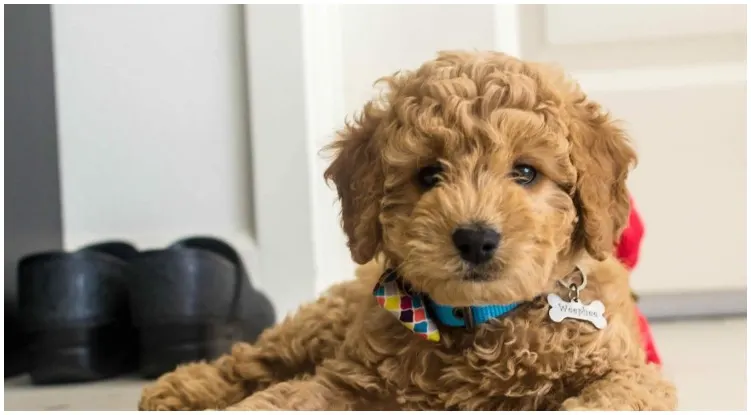We all love Doodles, or Poodle mixes. And one of the most popular Doodle mixes is the Toy Goldendoodle. It is a cross between the Golden Retriever and the Toy Poodle. Clearly, this is a crossbreed that inherits traits from both parent breeds.
The Toy Goldendoodle is definitely one of the most popular crossbreeds out there, and it’s not too hard to see why. They basically look like living, tiny teddy bears. In addition to that, both of their parent breeds are popular as well. So why wouldn’t their crossbreed be too? You’ll also love this Goldedndoodle size.
If you are interested to learn more about the Teacup or Toy Goldendoodle — keep on reading! Now, you should also know that the Toy Goldendoodle is not the same as the Mini Goldendoodle.
While you’re here you can learn more about Goldendoodles or their beautiful colors:
- Red Goldendoodle: Rare and expensive!
- Black Goldendoodle: What You Didn’t Know
- Golden Mountain Doodle: The smart tri cross
Toy Goldendoodle – What to know
Since the Golden Retriever and the Miniature Poodle are originally working dogs, their crossbreed will have these characteristics too. Toy Goldendoodle is a small dog, but it likes to work with its humans. These dogs are very smart and want you to challenge them despite their small size. They usually like to retrieve and love the water.
Living together with children and other animals isn’t a problem either with the Goldendoodle. But only as long as you train and socialize your dog. But, good news is that they are easy to train. They are all-around amazing dogs that will be loyal to their owners and friendly to everyone else. Toy Goldendoodles are gentle, clever and a joy to have around.
History
The country of origin of the Goldendoodle is the US. The first Goldendoodle reaches back to the 90s. Similar to the Labradoodle, the goal of crossing was to create a dog that is also suitable for allergy sufferers and combines the positive properties of the golden retriever and poodle. The popularity of the Labradoodle led to the emergence of other hybrid races too. Such as the Maltipoo (Maltese + Poodle), the Cockapoo (Cocker Spaniel + Poodle), or the Aussiedoodle (Australian Shepherd + Pudel).
The sudden interest in the dogs also has a dark side: Regardless of the health of the animals, the so-called designer dogs were bred to serve the market. Even today, it is important to pay attention to the choice of a conscientious breeder who can prove the health results of the parents and raise the puppies according to their needs.
Are they suitable for allergy sufferers?
You probably already know that Poodles are allergy-friendly. But is the Toy size Goldendoodle too? Well, the answer isn’t really clear. No one can predict if the poodle’s hypoallergenic coat prevails in the crossing between this breed and the Golden Retriever.
Secondly, it has been scientifically proven that the amount of allergen in the fur of a doodle is no different from that of other dog breeds. But, they shed a lot less — which is why they are considered allergy-friendly. But, there is currently no 100% hypoallergenic breed of dogs.
Allergy sufferers should spend some time with the puppies at the breeder to determine how they react to the animals. But even then, there is no guarantee that an allergy sufferer with the chosen dog will never show symptoms. Future dog owners should definitely be aware of this.
You should also know that there are F1B Toy Goldendoodles and F1 Toy Goldendoodles. So where’s the difference?
Well, an F1 Goldendoodle will shed more, be less hypoallergenic, but have better health via Hybrid Vigor. On the other hand, an F1B Goldendoodle will have a wavy or curly coat that sheds less and is more hypoallergenic.
What they look like
You can expect a full-grown Toy or Teacup Goldendoodle to grow to stand between 8 and 13 inches at the shoulder, which is roughly the same height as a sheet of A4 paper!
In addition to that, a full size Toy Goldendoodle can weigh as little as 7 pounds.
Their coat color and structure can vary greatly. It’s mostly medium-length and can be rather smooth or curly. Cream, gold, brown, reddish-brown, and black as well as color combinations occur.
Don’t underestimate the grooming. Their coat can matt quickly, depending on the type of fur they inherit. But, either way, regular brushing or shearing is a must. In addition to grooming, prevention against parasites, claw care, and veterinary examinations are also part of the care routine.
Toy Goldendoodle health and breeders
We always say that crossbreeds are healthier than their purebred parents. And that is true to some extent. This is because due to the so-called heterosis effect or also increased health through genetic mixing. Now, that is only true if both the parents are healthy.
This is where we need to tell you that both the Golden Retriever and the Poodle can genetically have eye and joint problems. Because of this, you need to buy your Goldendoodle puppy from a reputable breeder. One who breeds only with animals that don’t have any hereditary diseases.
Don’t be afraid to ask for health results when visiting the breeder. A good breeder can show you the results of the eye examination as well as the HD and ED examination (hip joint dysplasia and elbow dysplasia).
In addition, good breeders are happy to give insight into the pedigree, the breeding ground of the puppies, and are also available to the dog owners after delivery of the puppies.
Lastly, know that the average life expectancy of the toy Goldendoodle is between 11 and 15 years.

